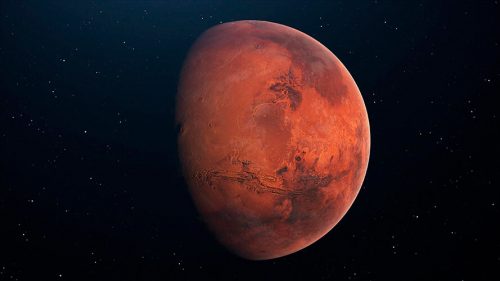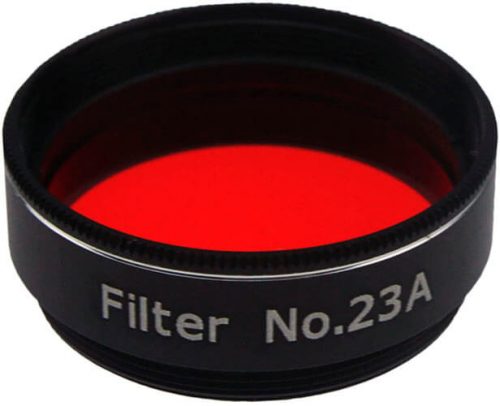How To View Mars Through A Telescope
Viewing Mars through a telescope is exceptionally interesting albeit, not very easy, because Mars will only come close enough to Earth once every two years or so.
It’s definitely worth the wait, though, because you’ll be able to view a decent amount of surface detail even using a relatively small telescope. You might also time your viewing to perfection and catch some of Mars dust storms and cloud banks.
Even if you’re a beginner and using your first telescope, Mars will be an excellent astronomical target to gain some experience in observing.

What Is Mars Close Approach?
Mars close approach is when Mars’ orbit is at the nearest point to Earth and will reach the highest point in the night sky at around midnight, in the southwestern sky. Gradually as the Earth and Mars move away from each other, Mars’ size will appear to diminish.
Mars close approach occurred in 2020, and the next one is due December 2022; during this time, Mars will only be 38 million miles from Earth.
The best time to view Mars is during “opposition.” This is when Mars is on the far side of Earth, “opposite side of Earth,” from the sun. During this period, which occurs every two years or so, Earth and the planet Mars are the nearest they will get to each other; naturally, Mars will also be at its brightest.
When Earth and Mars move near each other, you can see Mars as a bright object in the sky and can be seen with the naked eye; however, being this close only occurs once or twice every 15 to 17 years.
Mars Close Approach will occur about every 26 months.
When Is Mars Visible?
As we mentioned, 2020 was excellent if you wanted to get a really close look at Mars. Towards the end of 2020, Mars Close Approach placed the planet closer to Earth than it had been for the previous eight years.
2021 will not be near as good because there is no opposition, and Mars will become smaller and less visible as the planet moves towards the sun. Unless you possess an enormous telescope, you’ll not be able to view any of Mars’ surface features; neither can you see Phobos and Deimos, the two moons of Mars.
By October 2021, Mars’s orbit will take it behind the sun (it reaches conjunction), and the planet will not be visible until the very end of 2021. However, on either side of the conjunction, Mars will be visible.
Understanding Mars Opposition
Because the orbits of both Earth and Mars are ellipses and not circular, the distance between Earth and Mars varies tremendously.
Earth’s orbit is smaller than the orbit of Mars, so inevitably, Earth catches up with Mars; when this occurs, it’s called Mars Opposition because Earth is now in-between the sun and Mars. Because the Sun and Mars are now on opposite sides of Earth, when the Sun sets in the west, Mars rises in the east and can be seen all night. Mars opposition happens once every 26 months.
There is also a Very Close Mars Opposition that happens between 15 and 17 years when Mars reaches the closest point to the Sun and Earth passes between them.
In 2003 a Mars Opposition occurred that placed Earth and Mars less than 35 million miles apart; that distance was the closest the two planets had been in 60,000 years. On poor opposition years, Mars can sometimes be more than 60 million miles from Earth.
In addition, the dates of Mars Closest Approach and Mars Opposition can be off by numerous days and never fall simultaneously. Once again, because of the planet’s orbits, when Mars moves away from the Sun and Earth closest approach occurs several days before opposition. The exact opposite happens when Mars is moving towards the Sun and Earth.
Best Equipment For Viewing Mars
Telescopes
Providing you have a telescope with at least an aperture between 60mm and 90mm, you’ll be able to see some surface features, typically during opposition and roughly one month before and one month after. Image and resolution will not be that spectacular.
You will do best with telescopes that have superior light-gathering capabilities, longer focal lengths that offer higher magnification (150x plus). Two telescopes that possess these particular requirements are the Schmidt-Cassegrain and the Maksutov-Cassegrain.
Budget is naturally essential when discussing telescopes, as is the telescope’s weight. You’ll need to consider these two aspects carefully, but if you want to observe Mars at its very best, then you’ll need a telescope with large mirrors or lenses to collect the maximum amount of light.
Improving Your View With a Telescope Filter for Mars
It’s helpful to use a telescope filter to help reveal more of Mars’ features and improve surface contrast,
Filters can remove unnecessary light from what you’re viewing and leave behind only useful colors. When you’re looking at fewer colors, it’s much easier to distinguish the Martian surface features.
Some filters are more helpful in viewing Mars; click on the color for more information and the cost of the filters.
Filter for Telescope – #21 Orange
Orange #21 – This filter improves viewing of darker surface areas and filters out the color of the background planet.
Color/Planetary Filter – #23A Red
Red #23A – This filter is the best choice for all over Mars’ viewing.
Optical Filter #56 (Light Green)
Light Green #56 -Choose this filter to enjoy viewing the polar caps and dust storms
Color/Planetary Filter for Telescope – #82A Light Blue
Light Blue #82A – A blue filter, such as this, will help darken the overall red-colored planet and improves the polar cap view.
Using Astronomy Apps To Find Mars
Apps are the modern go-to method for stargazing; they can be beneficial and save a great deal of time. Most purchases of any decent telescope will include planetarium apps you can download for your Android or iOS device.
If you don’t want to use the app from the telescope manufacturer, there are several choices of free and paid apps on the Apple App Store or Google Play. Some of the apps available will allow you to point your device at the night sky and tell you what you’re looking at.
If you want an app specifically for Mars, search online to find one that offers celestial coordinates, real-time sky map, etc.
Observing Mars – What To Look For
If you’re a regular observer of Mars, you might notice subtle variations from opposition to opposition; however, there can sometimes be notable changes.
Patience and a large aperture telescope are what you’ll need to obtain the best views of Mars. The stand-out features you should aim to view during an opposition are:
Mars Phases
Unfortunately, you will not see the whole range of phases because Mars doesn’t orbit the sun inside of Earth’s orbit, unlike Mercury and Venus, which let you see the total range of phases.
Mars, Saturn, Uranus, Neptune, and Jupiter orbit the sun outside of Earth’s orbit and remain close to or full.
The smallest phase you will see is when Mars is at quadrature.
Polar Ice Caps of Mars
Mars is similar to Earth in that the planet has a North and South Pole. However, unlike the ice water polar ice caps on Earth, Mars’s polar caps are carbon dioxide ice and water ice underneath. During the summer on Mars, the carbon dioxide vaporizes and then re-freezes in the winter months.
Land Formations of Mars
Mars looks red because of the iron-rich minerals covering the surface; the iron rusts give the soil its red color.
The atmosphere on Mars is incredibly thin, around 50 times thinner than the atmosphere at the top of Mount Everest on Earth. The thin atmosphere probably means no liquid water exists on the planet.
However, the highest mountain in our solar system is on Mars. Olympus Mons is roughly three times the height of Everest or seventeen miles. In 1971 the Mariner 9 probe discovered a system of valleys that is 2500 miles long and 6 miles deep, which is practically the entire width of Australia; Nasa named the valleys after the Mariner probe – Valles Marineris.
The northern hemisphere has three features, which early astronomers took to be oceans, Acidalia Planitia, Syrtis Major, and a dark area around the pole.
Martian Dust Storms
Martian dust storms are another prominent feature of Mars; however, they are pretty unpredictable and seem to happen once every five years. There was an enormous dust storm in 2018 that covered the entire planet; viewing was virtually impossible that year.
Conclusion
View Mars through a telescope as frequently as possible because it takes Mars just over 24 hours to rotate, and over a period of weeks, you’ll get to see many different surface areas.
You can also extend your viewing time, especially when Mars is approaching an opposition.
Unfortunately, astronomers only get to view Mars for three to four months every 26 months. On the plus side, it allows plenty of time for astronomers to get prepared and still feel the excitement because Mars is the one planet every astronomer wants to explore.






















